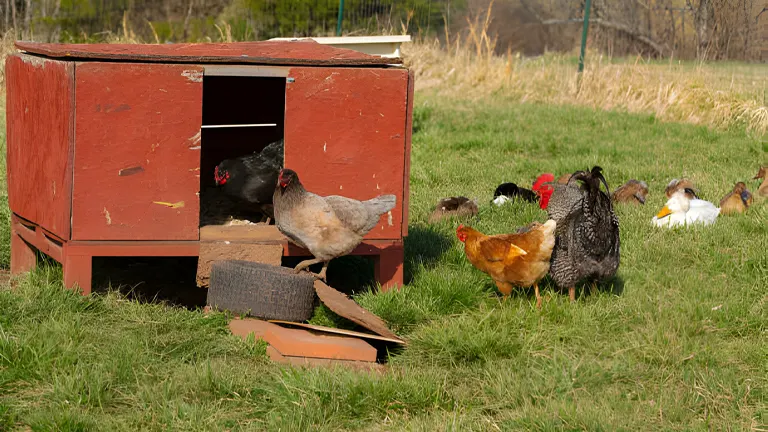Top 5 Chicken Coop Designs for Backyard Farmers: Ultimate Guide
- February 29, 2024
- 6 comment
Embarking on the path of backyard farming, especially raising chickens, has transformed from a simple task into a comprehensive journey for me. The decision to integrate chickens into my farming activities brought with it the critical understanding that their living environment—the chicken coop—would be fundamental to our mutual success.

Far from being just a basic shelter, a chicken coop serves as the central hub for a flourishing poultry environment. The primary goal extends beyond mere protection; it encompasses the creation of a conducive environment that nurtures the chickens’ well-being, happiness, and overall productivity.
List of Top 5 Chicken Coop Designs for Backyard Farmers
- The Versatile Chicken Tractor Coop
- The Pastured Poultry Pen Coop
- The A-Frame Charm Coop
- The ChickShaw Coop
- The Static Sanctuary Coop
The 5 Dynamic Quintet of Coops
In the following discussion, I will detail the five distinct types of chicken coops that have significantly enhanced my farming practices. Additionally, I will outline crucial guidelines for designing an ideal chicken habitat that meets the essential needs of poultry care.
1. The Versatile Chicken Tractor Coop
My journey begins with the chicken tractor, a mobile marvel that serves multiple purposes on my farm. Housing up to 12 birds, this coop on wheels has been a chicken hotel, garden tiller, maternity ward, and even a broiler pen.

Its mobility, combined with features like external access nesting boxes and built-in perches, makes it an indispensable tool. Constructing one cost me less than $200, a small price for its vast benefits.
2. The Pastured Poultry Pen Coop
Inspired by Joel Salatin’s designs, this pen champions pasture-raised poultry. It can comfortably house up to 75 birds and is equipped with PVC skids for easy movement.

I’ve adapted mine with nesting boxes, transforming it into a multi-functional space that supports both meat and laying hens in their natural foraging environment.
3. The A-Frame Charm Coop
A-frame coop is a testament to simplicity and efficiency. Perfect for transitioning chicks or housing a small flock, its design includes removable wheels and exterior-access nesting boxes.

This coop not only serves as a secure shelter but also as a portable garden worker, moving around to prep the land for planting.
4. The ChickShaw Coop
My favorite, the ChickShaw, is a one-person operated, mobile coop that can transport a large flock across varied terrains.

Its design prioritizes the chickens’ need for shade, ventilation, and roosting space, with large wheels to navigate through the farm easily. This coop stands as a testament to innovative farming, making poultry management both efficient and enjoyable.
5. The Static Sanctuary Coop
While I primarily focus on mobile coops, the static coop holds its ground, especially for those with limited space or mobility.

It serves as a fixed hub for my guineas and a compost generator, utilizing deep bedding to create rich soil amendments. Despite its immobility, its contributions to my farm’s ecosystem are invaluable.
Crafting the Perfect Coop: The Four Cornerstones
- Shelter and Comfort: A coop must provide protection from the elements, with at least one square foot of space per bird. It should shield them from wind and rain while offering ample shade and ventilation.
- Access to Sunlight and Fresh Air: Half of the coop should be open or have windows facing the sun to ensure adequate light and air circulation. This is crucial for the birds’ health and well-being.
- Predator Proofing: Ensuring the coop is secure against predators is non-negotiable. All openings should be smaller than an inch, and the coop should be locked up tight at night.
- Easy to Manage: From egg collection to cleaning, the design should allow for easy maintenance. Features like external nesting boxes and a design that facilitates natural cleaning processes are key.
The Must-Have Features for Ultimate Functionality
- Perches: Mimicking their natural roosting behavior, perches should be spacious yet cozy for nighttime.
- Nesting Boxes: A secluded spot for laying eggs, easily accessible for collection.
- Dust Boxes: Essential for chicken hygiene, allowing them to bathe and deter pests.
- Food Supplements: Proper containers for grit and other supplements ensure healthy digestion and nutrition.
Additional Tips for Optimizing the 5 Ingenious Chicken Coop Designs
- Maximize Space Efficiency: For small backyards or urban farms, consider vertical coop designs or multi-level perches to maximize space. This approach allows you to provide ample living area for your chickens without sacrificing valuable yard space. Additionally, integrating vertical gardening on the sides of your coop can offer shade and food for your chickens while utilizing the same footprint.
- Customize for Climate: Adapt your chosen coop design to suit your local climate. In colder regions, consider adding insulation and winter-proofing features such as double-pane windows or a small coop heater with a thermostat. For warmer climates, focus on enhancing ventilation and shading options, like removable panels or a white reflective roof, to keep your chickens cool during hot months.
- Incorporate Automation: Simplify your daily poultry management tasks by incorporating automatic systems into your coop design. Automatic waterers, feeders, and egg collection systems can save time and ensure your chickens always have access to fresh water and feed. Installing an automatic door that opens at dawn and closes at dusk can also help protect your flock from predators.
- Sustainability Practices: Implement sustainable practices into your coop design to reduce waste and increase efficiency. Composting chicken manure directly beneath the coop (for stationary designs) or in designated areas (for mobile coops) can provide you with rich fertilizer for your garden. Rainwater harvesting systems can be installed to collect water for your chickens, reducing water usage. Lastly, consider using recycled or locally sourced materials for building your coop to minimize the environmental impact.
Related Articles:
- Best Bedding For Chickens
- Best Safe Chicken Coop Heater
- 8×8 Chicken Coop Plans
- Turning a Shed Into a Chicken Coop
- How to Make a Chicken Coop Out of Pallets
- Best Sand for Chicken Coop
- How To Insulate a Chicken Coop
- How To Heat a Chicken Coop
- How To Keep Water from Freezing in Chicken Coop
- How to Build a Chicken Coop
- How To Build Chicken Nesting Boxes
- How to Raise Happy and Healthy Chickens in Your Backyard
- When Can Chicks Go Outside? Timing and Tips for a Smooth Transition
- 12 Reasons why Ducks are Better than Chickens
- Best Automatic Chicken Coop Doors 2024: Expert Reviews & Buyer’s Guide
- Best Fans for Chicken Coop 2024: Effective Cooling Solutions Reviewed
- Designing the Perfect Low-Maintenance Chicken Coop: Your Ultimate Guide
- Transforming Chicken Feed: My DIY Black Soldier Fly Bin Experience
- Backyard Chickens: A Step-by-Step Guide for First-Timers
Final Reflections on Backyard Poultry Management
My foray into backyard farming has taught me that the right coop is more than a shelter; it’s a foundation for sustainable poultry care. It has become clear that a coop serves as much more than just a protective enclosure; it is the cornerstone of effective and sustainable chicken care. The diverse array of coops I’ve implemented, each with its distinct features and benefits, has significantly enhanced the productivity of my farming activities and has greatly improved the quality of life for my chickens.
For anyone engaged in poultry farming, from the experienced to those just beginning, adopting these coop designs and principles is transformative. It not only elevates the overall experience of managing poultry but also cultivates a positive and productive environment for both the chickens and their keepers.
Frequently Asked Questions
- What are the key features of an ingenious chicken coop design?
Key features include mobility for pasture management, predator-proofing, adequate ventilation, access to sunlight, easy egg collection, and designs that facilitate cleaning and maintenance. - How do I choose the right chicken coop design for my backyard?
Consider your flock size, space availability, climate, and your main goals (e.g., egg production, meat, composting). Select a design that aligns with these factors and your management style. - Can these coop designs accommodate both layers and broilers?
Yes, each design can be adapted or is suitable for housing either layers or broilers, with certain coops being more optimized for one purpose over the other. - Are mobile coops better than static ones?
Mobile coops offer benefits like rotational grazing and ease of cleaning by moving the coop to fresh ground. However, static coops can be beneficial for fixed setups or smaller spaces. The choice depends on your farming practices and space. - How can I make my chicken coop predator-proof?
Ensure all openings are smaller than 1 inch, use hardware cloth instead of chicken wire, secure doors and windows with locks, and consider an apron or buried wire to prevent digging predators. - What materials are best for constructing a chicken coop?
Durable materials that withstand weather and predators, such as treated wood, metal for roofing, and hardware cloth for ventilation windows. Recycled materials can also be used effectively. - How much space do chickens need in a coop?
As a general rule, provide at least 1 square foot per chicken inside the coop and about 8-10 square feet per chicken in an outside run. - How do I manage ventilation without making the coop too cold for the chickens?
Place ventilation openings near the roof to allow hot air to escape without creating drafts at the level where chickens roost. Ensure there’s enough ventilation to prevent moisture buildup without causing direct cold airflows on the birds. - What is the importance of nesting boxes and how many do I need?
Nesting boxes provide a safe, comfortable place for hens to lay eggs. Typically, you need one nesting box for every 3-4 hens. - Can I use one of these coop designs in an urban backyard?
Absolutely. Several of the designs can be scaled down or adjusted to fit smaller, urban spaces while still providing your chickens with a comfortable and productive living environment.
We’re eager to connect with you! Share your own stories and feedback about the “5 Ingenious Chicken Coop Designs for Every Backyard Farmer” in the comments below. Your personal experiences and insights can provide invaluable guidance to fellow enthusiasts looking to optimize their backyard farming setups. Let’s help each other make well-informed choices for our feathered friends!

Edward Smith
Forestry AuthorWoodworking is about more than crafting; it's a harmonious connection with nature, mastering tools, and preserving our environment. I'm here to share my knowledge and experiences with you, forging a future where we can embrace wood's beauty and utility while safeguarding our forests' health and diversity.
6 comments
The A.frem coop where can you put the drinker?
Andy konah
March 8, 2024 6:15 amHi Andy, For an A-frame chicken coop, place the drinker either inside for protection from the elements or outside in the run area to keep the interior dry. Ensure it's accessible, at the right height, and in a shaded spot to keep water cool.
Edward Smith
March 11, 2024 7:03 amVery nice and convenient
todd moore I'm
March 4, 2024 3:25 pmYour work is highly appreciated and am starting just tomorrow and from there you will hear more from me. Stay blessed.
Alphonse F ASUMAH
March 3, 2024 7:38 pmIt looks very beautiful I will also need mine but I need which can fit 100 chickens thanks













How much a local chick?
Eladu Jacob
March 8, 2024 3:29 pm